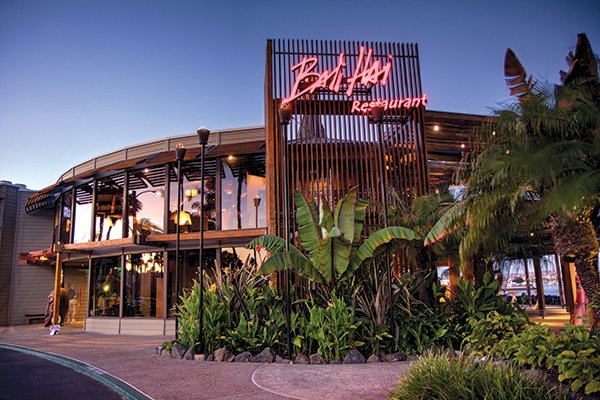 Facebook
Facebook
 X
X
 Instagram
Instagram
 TikTok
TikTok
 Youtube
Youtube

If the Tiki god doesn't exactly admire the state of San Diego journalism, what does he think about a gaggle of mid-20th century nostalgia worshippers soon to emerge from over the horizon?
Such is a question of currency at Bali Hai, the historic pseudo Polynesian outpost on Shelter Island that recently saw a norovirus take down more than a few remaining members of San Diego's already dissipated press corps.
Of the 60 or so who got sick at the July 29 Society for Professional Journalists annual awards fest, "Three samples have come back from patients that were positive for Genotype 1 strain of norovirus. This is a less common strain than Type 2, which causes most of these illnesses," according to the Food Poisoning Bulletin. "Officials don’t know yet if contaminated food was the cause, or if the virus was spread person-to-person," said the bulletin, apparently discounting the wrath of Tiki.
"Someone who prepared the food may have been ill and spread the virus."
According to county "food facility inspection" information posted online, a July 31 inspection after the incident found "major violations" regarding "food contact surfaces."
A subsequent August 3 inspection by the county turned up "minor violations" in "plumbing" and "thawing methods."

As previously reported here last fall, the Bali Hai has a vaunted reputation among legions of 1950's Tiki culture fanatics.
Opened in 1955 by Los Angeles exile Tom Ham, the venue was one of a number of popular South Seas-themed restaurant and grog shops that beckoned Americans looking to escape nagging fears of nuclear annihilation.
“Tiki defied the modern, like a Maori warrior wagging his tongue at an adversary," writes historian Kevin Starr in his Golden Dreams: California in an Age of Abundance, 1950–1963.
"Tiki suggested that cops and firemen could be beachcombers for a night, stockbrokers could be South Seas traders, suburban housewives in leis, muumuus, or sarongs could imagine themselves elsewhere, in a place transformed and magical.
"Tiki said to hell with it. If only for tonight, let’s party!”
Helped along by cable TV's Mad Men and the midcentury historical preservation movement, Tiki culture has been rediscovered by succeeding generations.
Next weekend, Tiki Oasis 2015 is set to open here for its annual three-day San Diego extravaganza, featuring lots of grog and 30 sessions on topics including Bartending Techniques of the Modern Age; Pin Up Posing 101; Myths, Mysteries and Misconceptions of Rum; and Hangover, Stretch it Out.
On Thursday, the festival begins with its traditional 6 p.m. "mix and mingle" at the Bali Hai. Sponsors did not respond to messages regarding details of the event, in the past noted for “imbibing a few of the Bali Hai Mai Tais which are more like a Zombie with a rum float or a Long Island Ice Tea without the tea" and a "Sultry Savage Burlesque," according to the Tiki Oasis website.

Sex and booze, not so much the food, has always been a primary staple of Bali Hai's legend.
"Tiki was helping to create a myth and identity for ordinary Americans: a design and style that contained within itself a strong note — at least on the level of fantasy — of sexual liberation, of escaping the Puritan restraints of American life,” is how historian Starr puts it.
After Bali Hai founder Tom Ham dropped dead at the Bali Hai in November 1973 while hyping the establishment to a local reporter, two cocktail waitresses emerged to claim the swinging restaurateur had fathered an illicit child with each.


If the Tiki god doesn't exactly admire the state of San Diego journalism, what does he think about a gaggle of mid-20th century nostalgia worshippers soon to emerge from over the horizon?
Such is a question of currency at Bali Hai, the historic pseudo Polynesian outpost on Shelter Island that recently saw a norovirus take down more than a few remaining members of San Diego's already dissipated press corps.
Of the 60 or so who got sick at the July 29 Society for Professional Journalists annual awards fest, "Three samples have come back from patients that were positive for Genotype 1 strain of norovirus. This is a less common strain than Type 2, which causes most of these illnesses," according to the Food Poisoning Bulletin. "Officials don’t know yet if contaminated food was the cause, or if the virus was spread person-to-person," said the bulletin, apparently discounting the wrath of Tiki.
"Someone who prepared the food may have been ill and spread the virus."
According to county "food facility inspection" information posted online, a July 31 inspection after the incident found "major violations" regarding "food contact surfaces."
A subsequent August 3 inspection by the county turned up "minor violations" in "plumbing" and "thawing methods."

As previously reported here last fall, the Bali Hai has a vaunted reputation among legions of 1950's Tiki culture fanatics.
Opened in 1955 by Los Angeles exile Tom Ham, the venue was one of a number of popular South Seas-themed restaurant and grog shops that beckoned Americans looking to escape nagging fears of nuclear annihilation.
“Tiki defied the modern, like a Maori warrior wagging his tongue at an adversary," writes historian Kevin Starr in his Golden Dreams: California in an Age of Abundance, 1950–1963.
"Tiki suggested that cops and firemen could be beachcombers for a night, stockbrokers could be South Seas traders, suburban housewives in leis, muumuus, or sarongs could imagine themselves elsewhere, in a place transformed and magical.
"Tiki said to hell with it. If only for tonight, let’s party!”
Helped along by cable TV's Mad Men and the midcentury historical preservation movement, Tiki culture has been rediscovered by succeeding generations.
Next weekend, Tiki Oasis 2015 is set to open here for its annual three-day San Diego extravaganza, featuring lots of grog and 30 sessions on topics including Bartending Techniques of the Modern Age; Pin Up Posing 101; Myths, Mysteries and Misconceptions of Rum; and Hangover, Stretch it Out.
On Thursday, the festival begins with its traditional 6 p.m. "mix and mingle" at the Bali Hai. Sponsors did not respond to messages regarding details of the event, in the past noted for “imbibing a few of the Bali Hai Mai Tais which are more like a Zombie with a rum float or a Long Island Ice Tea without the tea" and a "Sultry Savage Burlesque," according to the Tiki Oasis website.

Sex and booze, not so much the food, has always been a primary staple of Bali Hai's legend.
"Tiki was helping to create a myth and identity for ordinary Americans: a design and style that contained within itself a strong note — at least on the level of fantasy — of sexual liberation, of escaping the Puritan restraints of American life,” is how historian Starr puts it.
After Bali Hai founder Tom Ham dropped dead at the Bali Hai in November 1973 while hyping the establishment to a local reporter, two cocktail waitresses emerged to claim the swinging restaurateur had fathered an illicit child with each.
Comments